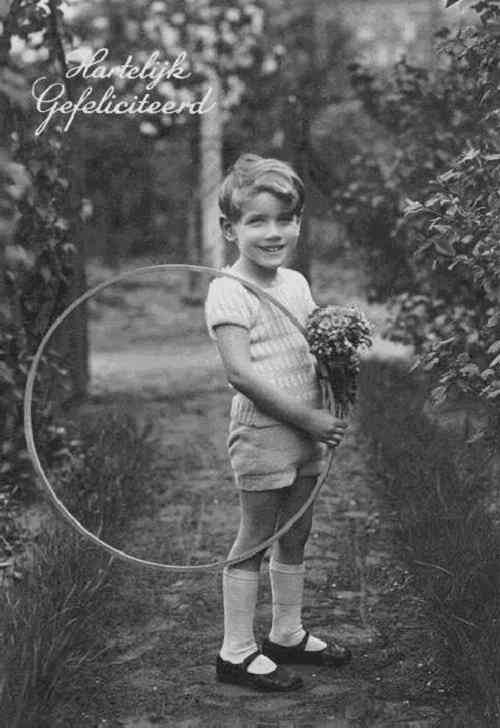
Dutch Boys' Clothes: Chronology--Inter-War Years (1930s)

Figure 1.--This postcard shows the a young boy wearing an inormal collarless shirt and the shorter cut short pants worn in the 1930s. Note the rather formal white kneesocks and strap shoes. Using post cards to illustrate fashion trends is a little complicated. This card was postally used in the Nretherlands in 1935, but we do not know where it was made.
|
Boys fashions in the 1930s take on an increasingly modern look, especially shirts and sweaters. Boys wear both collared and colarless shirts. Shirts similar to modern "T"-shirt are seen. Kneepants are no longer seen. Short pants are widely worn by boys year round. The cut is increasingly short, especially for younger boys. Older boys might wear knickers, especially during the winter. Both kneesocks and ankle socks are worn. White kneesocks had a rather dressy look. Some boys wore sandals. Younger boys might wear strap shoes with dressy outfits. Folk dress was still seen in some isolated areas, but to a much lesser extent than in the pre-World War I era.
Appearance
Boys fashions in the 1930s take on an increasingly modern look, especially shirts and sweaters.
Garments
Shirts
Boys wear both collared and colarless shirts. Shirts similar to modern "T"-shirts are seen. A knitted short sleve collarless can be sen here on this page (figure 1).
Pants
Kneepants are no longer seen. Short pants are widely worn by boys year round. The cut is increasingly short, especially for younger boys. Older boys might wear knickers, especially during the winter.
Most of the trousers were woolen, cotton or corduroy of good quality, because they had to be indestructable. Those pants were made in
the Netherlands.
Hosiery
Both kneesocks and ankle soicks are worn. White kneesocks had a rather dressy look.
Footwear
Some boys wore sandals. Younger boys might wear strap shoes with dressy outfits.
Ethnic Clothing
Folk dress was still seen in some isolated areas, but to a much lesser extent than in the pre-World War I era.
School Clothes
Dutch schools did not require uniforms. A Dutch reader reports rgat in the 1930s when he went to school, he and his friends always wore short pants, except in the winter when they wore so-called "rijbroeken" (riding breeches). Boys by the late 1930s were beginning to wear knickers at about age 12-13 knickers.
Christopher Wagner

Navigate the Boys' Historical Clothing Web Site:
[Introduction]
[Activities]
[Bibliographies]
[Biographies]
[Chronology]
[Clothing styles]
[Countries]
[Contributions]
[FAQs]
[Dutch glossary]
[Satellite sites]
[Boys' Clothing Home]
Navigate the Boys' Historical Clothing Dutch pages:
[Maiken Island]
[Dutch boys bangs]
[Dutch choirs]
[Dutch school uniform]
[Dutch catalogs]
[Dutch post cards]
[Dutch royals]
[Dutch youth groups]
Navigate the Boys' Historical Clothing national pages:
[Return to the Main Dutch inter war chronological page]
[Return to the Main Dutch page]
[Australia]
[Belgium]
[England]
[France]
[Germany]
[Ireland]
[Italy]
[Japan]
[Korea]
[Mexico]
[Scotland]
[United States]
Created: November 16, 2001
Last updated: December 23, 2001



